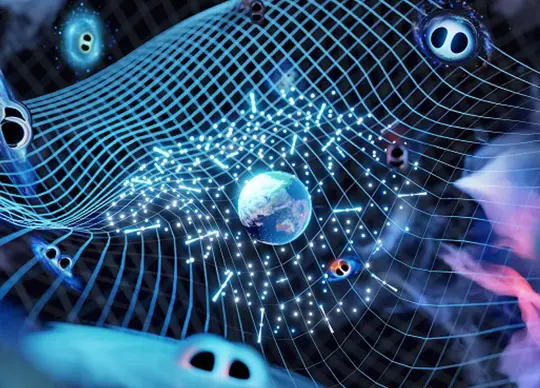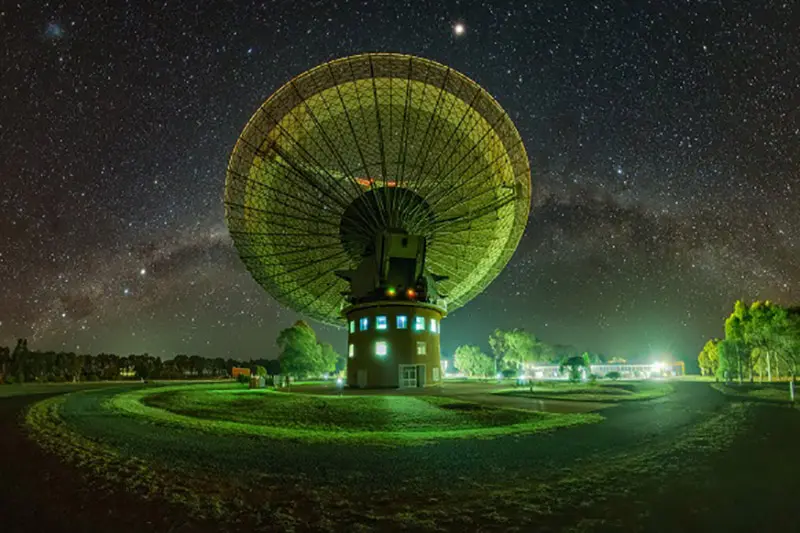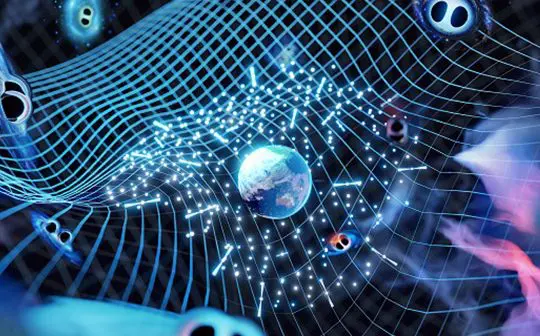

Image 1: Pulsar-Timing-Array.
Astronomers using data collected by CSIRO’s Parkes radio telescope, Murriyang, have found their strongest evidence yet for low-frequency gravitational waves.
For nearly 20 years the Parkes Pulsar Timing Array collaboration has monitored a set of rapidly spinning stars that pulse like a lighthouse, called pulsars.
They are looking for nanosecond pulse delays caused by gravitational waves to provide further evidence for Einstein’s general theory of relativity and build on our understanding of the Universe.
By compiling and analysing this large data set, the team has taken another step towards detecting gravitational waves through the study of pulsars.
Their latest results have been published today in The Astrophysical Journal Letters and Publications of the Astronomical Society of Australia.
In 1916 Albert Einstein proposed space-time as a four-dimensional fabric, and that events such as exploding stars and merging black holes create ripples – or gravitational waves – in this fabric.
Almost a century later, in 2015, researchers from the LIGO and Virgo collaborations made the first direct observation of gravitational waves caused by the collision of two stellar-mass black holes.
In contrast to these gravitational waves, which oscillate multiple times per second, the Parkes Pulsar Timing Array collaboration is searching for gravitational waves emitted by binary supermassive black holes at the centres of galaxies. These gravitational waves oscillate over timescales of many years.

Image 2: CSIRO-Parkes-Radio-Telescope-Murriyang-credit-Alex-Cherney.
OzGrav and Swinburne University of Technology researcher Dr Daniel Reardon, who led the searches, said that as these gravitational waves pass through our galaxy and wash over the Earth, they will change the apparent rotation frequency of fast-spinning pulsars.
“We can detect gravitational waves by searching for pulses that arrive earlier or later than we expect. Previous studies have shown an intriguing signal in pulsar timing array observations, but its origin was unknown,” Dr Reardon said.
“Our latest research has found a similar signal among the set of pulsars we’ve been studying, and we now see a hint of the fingerprint that identifies this signal as gravitational waves.
“Unlike stellar-mass bursts of gravitational waves, supermassive black holes take years or decades to complete their orbits, and so their signature takes a decade or more to emerge,” he said.
Astronomers around the globe have been busy chasing this gravitational-wave signal by studying pulsars.
Other collaborations in China (CPTA), Europe (EPTA), India (InPTA) and North America (NANOGrav) see a similar signal in their data; their results are also published today in several journal papers.
CSIRO astronomer Dr Andrew Zic, who co-led the analysis, said that while it is exciting all the major collaborations are seeing hints of the waves the true test will come in the near future, when all of the data is combined into a global dataset.
“This signal could still be caused by things like variations in a pulsar’s rotation over a long period of time, or may simply be a statistical fluke,” Dr Zic said.
“Our Parkes radio telescope, Murriyang, has an advanced receiver and an excellent view of the best pulsars in the southern sky, which are essential for this work.
“The next step is to combine pulsar data sets collected by telescopes in both the northern and southern hemispheres to improve the sensitivity of our observations,” he said.
Through the International Pulsar Timing Array consortium, the individual groups around the globe – including the Parkes Pulsar Timing Array collaboration in Australia – are working together to combine their data to better characterise the signal and confirm its origin.
“The next stage of our research will combine the full power of the global array and rule out any anomalies,” said Dr Zic.
Using pulsars to confirm the detection of low-frequency gravitational waves will expand this emerging area of science, to be explored further by new instruments including the SKA telescopes currently being built in Australia and South Africa.





